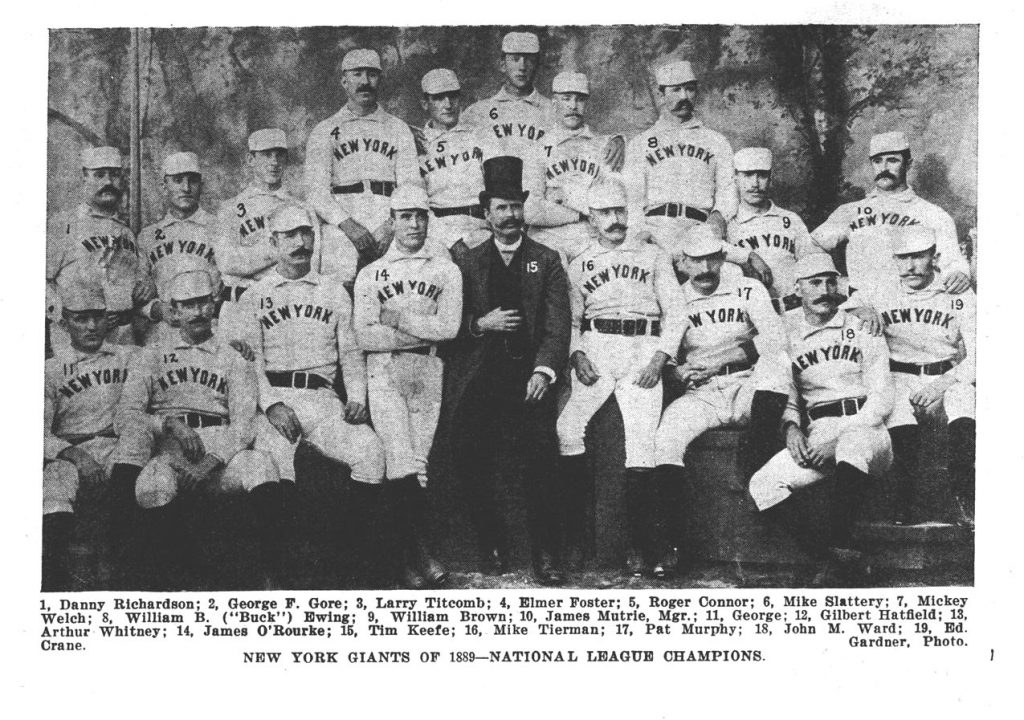Get email updates
The new CubTalks episode and more, direct to your inbox.
I have Irish lineage on both sides of my family tree. In particular on the Sheridan side, where my Great, Great, Grandparents came to the U.S. in 1862. Arriving in New York, they, like other Irish immigrants of that time, were treated harshly and with disdain…think of the film Gangs of New York. However, my family pushed on immediately to a place they’d heard about that had inexpensive land and golden opportunities – Minnesota. But, this is about baseball, so let’s move the story forward nine years and back to New York.
Professional Baseball Started 150 Years Ago on St. Patrick’s Day in New York!
On March 17, 1871 (St. Patrick’s Day), in a bar in New York City aptly named “Collier’s Café”, the National Association of Professional Baseball Players was officially formed, becoming the very first professional baseball league in the world. While the league has long been defunct and replaced with today’s Major League Baseball, the origins of the professional game are found on St. Patrick’s Day.

Also in 1871, a strapping 14-year-old young man named Roger set off for New York, where he worked odd jobs while trying to catch on with junior baseball teams as a left-handed third baseman. Yes, left-handed third baseman were a thing then. It took him some time to mature and grow, but eventually Roger became the first prominent signee of the fledgling New York Gothams. His full name was Roger Connor, whose parents had come to the U.S. from Ireland shortly before his birth.
Roger Connor’s career would eventually expand to 18 years of Major League service and land him in the baseball Hall of Fame. Connor had several claims to fame, most of which are largely forgotten. Among them, on September 10, 1881 he hit the very first Grand Slam (a walk-off winner), and went on to become the All-time career home run leader. A home run record that lasted for 23 years, until a guy named Babe Ruth broke it. Interestingly, that 14-year-old kid, Roger, who eventually wound up in New York, was still growing…finally reaching 6’3″ and a stout 220 lbs, quite sizable for that era. Which brings us to perhaps Connor’s most lasting legacy in baseball, being the foremost reason that the New York Gothams changed their name to the Giants (now the San Francisco Giants). The man fans affectionately called, ‘Dear Old Roger,’ created a large shadow in Gotham.

In 1883, Connor had his finest season to that date, ranking second in the league in batting average (.357), and in the top three in hits (146), on-base percentage (.394), slugging (.506), total bases (207), and triples (15).
With six Cooperstown-bound players in Gotham’s uniform for the 1885 season, the team played superb baseball, compiling an 85-27 record, the best ever recorded for a team that finished in second place. Incredibly, the Chicago White Stockings (now Cubs), with Cap Anson, King Kelly, and John Clarkson in the prime of their own illustrious careers, had been two games better.
It was during 1885 that the Gothams became the Giants. It’s no wonder the new name fit, as Connor stood tall above the rest, having arguably the finest season of his 18-year major-league career. The 28-year-old slugger won the National League batting crown with a .371 average. Connor also led the league in hits (169), total bases (225), and on-base percentage (.435) top-five in triples (15), slugging (.495), OPS (.929), walks (51), and runs scored (102). Perhaps even more remarkable, the sweet swinging lefty struck out only eight times in 506 plate appearances. A speedy man for his size, Roger unnerved opposing infielders with base path prowess and a hard pop-up slide, a maneuver he was the first to popularize.
One of Connor’s Herculean home runs was on September 11, 1886 where he hit the first home run to clear the stadium confines at the original Polo Grounds, a monster late-season wallop off Providence ace Hoss Radbourn. So impressed were members of the New York Stock Exchange that they passed around a black top hat and took up a collection that eventually led to the presentation of a $500 gold watch to Connor.
By 1888 the star-laden Giants roster finally played to its potential, winning the pennant. Connor placed in the league top five in almost every offensive category. He was solid in the postseason as well, batting .303 as the Giants topped the American Association champion St. Louis Browns in the 1888 postseason series.
Upon completion of the 1888 season, White Stockings Owner and serial entrepreneur Albert Spalding, launched an unprecedented baseball tour around the world. He took his White Stockings ballclub and a team of All-Stars to promote American baseball around the world. Roger Connor, who was never the flamboyant type, did not go on the grand tour. However, his gregarious Giants teammate, John Montgomery Ward, joined the journey playing for the All-Stars. After playing 28 games abroad in eight different countries, the teams played their final foreign contest in Ireland on March 27, 1889, at the famous Landsdowne Road stadium in Dublin before returning to the United States.

By 1897 Connor’s career was winding down and it was his last major league season. His career totals in just under 2,000 games, he compiled 2,542 base hits and a .323 lifetime batting average. His 138 career home runs were the major-league standard, until broken by Ruth. And Connor’s 233 triples remain the most ever hit by an exclusively 19th-century player. In addition he had over 1,000 walks (against only 453 strikeouts), and four times a league leader in fielding percentage for a first baseman. And from the 1886 season on (when statisticians started keeping track of such things), he had been credited with 244 stolen bases.
Upon retirement, Connor could not get baseball out of his blood. He moved back to Connecticut, played, managed, and eventually owned minor/semi pro teams over the next decade plus. It was during this time period that a song composed by Jack Norworth in 1908, titled, “Take Me Out To the Ballgame “, came out.
The song told the story of baseball-mad Irish female fan Katie Casey and her adventures at the ballpark. While baseball fans across the world know the chorus of baseball’s unofficial anthem by heart, very few know the song verses that told the story of Katie Casey. The song was an instant hit. However, Norworth rewrote the song in 1927 and removed all references to Katie Casey.
Roger Connor continued to play baseball intermittently for the Waterbury Elks Club and other local teams until an injury on the field persuaded him to hang it up for good in the fall of 1910. He was then 53 years old. And that’s where I’ll leave this Irish baseball themed story of a man who loved baseball so much, he couldn’t stop playing until injury forced him to finally retire his bat permanently. He was baseball’s first power hitter of the Dead Ball era. Before Babe Ruth became the Sultan of Swat, he had to take the title from the original Giant – Roger Connor.
Happy St. Patrick’s Day!
No Comments